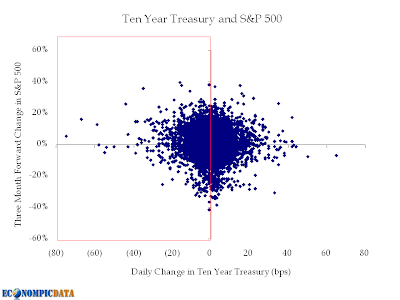Before I dive in, I am not making the case that the Private Public Partnership likely to be announced Monday morning will in fact work. In addition, I am not making the case that the government should be providing a subsidy to private investors. What I am attempting to do is detail how it can work.
Thus, while I don't typically disagree with Yves from Naked Capitalism, her post Investor on Private Public Partnership: "One would have to be a criminal to participate in this" misses a HUGE detail of the plan (to be fair, I believe she nails it in a previous post here). First the basic assumptions in her example:
- Citi holds $100mm of face-value securities, carried at $80mm.
- The market bid on these securities is $30mm.
- Say with perfect foresight the value of all cash flows is $50mm.
- The investor buys the assets for $75mm, putting only 3% down and borrows the rest from the government (FDIC and Treasury) at a low rate.
Yves makes the case that this investment will no doubt result in a loss of $25mm. The line "say with perfect foresight the value of all cash flows is $50mm" combined with Yves stating the example “did not allow for time value of money” reveals her example is oversimplified to the point of missing what I feel is the most important part of the plan... that the plan reduces the rate at which the cash flows of the assets are discounted, which increases the present value of those cash flows.
Cheap Financing = Lower Discount Rate = Higher Asset PricesIn the example, the securities will only have $50mm in total cash flows, which equals the present value of those cash flows due to the ignoring of the time value of money. That makes the Private Public Partnership seem like a loser... if there are only $50mm in cash flows and an investor pays $75mm, the plan would be foolish.
However, even at low market prices, cash flows are MUCH HIGHER than $50mm. A current $30mm market bid doesn't mean that the security will have $30mm (or $50mm) in cash flows. It means the present value of all future cash flows discounted at the required rate of return on capital is $30mm. A security that pays $5 each year for 10 years and $50 in year ten may be worth close to $30 if discounted at 16%, but the cash flows are the full $100.
Visually, the chart below details the present value of a security that pays out that $5 per year for 10 years and then $50 in year 10 using a variety of discount rates. While the present value of these cash flows (i.e. the price of the security) is close to $30 assuming a 15% required return, it becomes clear that the value changes based upon the required return of the investor.

And that is the point of the Private Public Partnership. The government has a VERY low required return on investment, which it is providing to the private sector via the partnership. How low? As of Friday, the U.S. government was able to borrow over 5 years at 1.64% and over 10 years at 2.63%. Thus, if the government makes a return above these levels on an investment, it MAKES money. On the other hand, a private investor (or bank) requires a substantially higher return (let's call it 15% in the case of these bad assets) from an investment or asset because their cost of capital is substantially higher.
The Mechanism; 97% Cheap FinancingCalculated Risk reports that:
The FDIC plan involves almost no money down.
The FDIC will provide a low interest non-recourse loan up to 85% of the value of the assets. The remaining 15 percent will come from the government and the private investors. The Treasury would put up as much as 80 percent of that, while private investors would put up as little as 20 percent of the money ... Private investors, then, would be contributing as little as 3 percent of the equity, and the government as much as 97 percent.
Thus, rather than discounting the cash flows at the required rate the private market requires (i.e. 15%), cheap government financing allows the cash flows of the security to be discounted at a much much lower rate (a weighting of 3% at the private rate and 97% at the government's much lower rate). This lower rate in turn props up the present value of all those cash flows (i.e. the asset price) AND makes it possible that BOTH the private investor and government can make money paying $75mm for assets currently priced significantly lower.
Is the program perfect? Not at all. For starters, I'd prefer the government go ahead and buy 100% of the assets and take 100% of the upside, but I understand the preference is to keep the assets in the hands of private investors. The important thing to remember is THERE IS NO PERFECT SOLUTION in the current environment and it is important to analyze how and why these plans may work before completely dismissing them.


















































